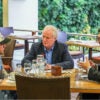In a rare admission of reality, a senior Russia Middle East hand, Duma Foreign Affairs Committee chairman Mikhail Margelov, acknowledged that Russia has “exhausted its arsenal” of support available to the Syrian dictator Bashar al-Assad.
Yet, despite Western diplomatic efforts, Russia continues to support Assad’s brutal regime. Peaceful protests against Assad’s dictatorship started the last spring. Since then, the regime’s response to these protests has claimed more than 5,000 lives, triggered a campaign of violence from the majority Sunnis, and spurred condemnations from the West and the Arab League.
The Daily Signal depends on the support of readers like you. Donate now
Russia considers the uprising in Syria, to some extent, the handiwork of the United States and its European allies. This perception is fundamentally wrong: Assad’s is a minority Alawi oppressive regime. In 1982, the father of the current dictator, then-President Hafez el-Assad, killed over 20,000 Islamist rebels in the town of Hama.
Russia has historically maintained close relations with Syria. It forgave almost three-fourths of Damascus’s massive debt in order to lure lucrative weapons orders. Not long after the U.S. imposed sanctions on Syria in 2004 for supporting Islamist terrorism and for allowing al-Qaeda fighters to cross into Iraq, Russia agreed in principle to sell Damascus a massive weapons package, which included war planes, short-range air defense systems, and anti-tank weapons.
President Dmitry Medvedev signed the formal military agreement in May 2010. In the last decade, Russia has sold well over a $1 billion in arms to Syria, including anti-tank missiles, surface-to-air missiles, and MiG 29/31 fighter aircraft. Russia also plans to construct a nuclear power plant in Syria. This is despite Israel’s destruction of a suspected covert nuclear reactor in the middle of the Syrian desert in September 2007.
Despite the growing isolation of Syria due to Assad’s brutal crackdown on the protesters, Russia continues to supply weapons and nuclear technology to this crumbling regime. Russia decided to deliver SS-N-26 Yakhont anti-ship cruise missiles. Actions such as these are destabilizing and dangerous. In 2006, Hezbollah used Russian anti-tank rockets provided by Syria against Israeli forces. Since then, Russia continues to deliver weapons to Syria despite pressure from the U.S. and Israeli governments. Likewise, arms and training from Iran continue to reach the hands of Hamas and Hezbollah via Syria.
Syria is just another example of the conflicting Russian and the U.S. approaches to the Middle East. A longtime sponsor of terror and Iran’s close ally, Syria poses a number of challenges to U.S. interests in the region. Damascus has aided and abetted attacks of foreign fighters on American troops and U.S. allies in Iraq and the destabilization of Lebanon. The now almost inevitable collapse of the Assad regime, which has ruled since 1970, constitutes a net loss from the Kremlin’s perspective.
Russia still clings to the rogue actor, once again highlighting the fact that the Kremlin’s first priorities are not cooperation with the United States or stability in the region but opposing Washington, securing economic gain, and expanding its own influence.
This year’s visit to Syria by a small Russian flotilla led by the only Russian aircraft-carrying cruiser, the Admiral Kuznetsov, in support of the embattled Assad regime clearly demonstrates Russia’s defiance of U.S. interests and disregard for the Obama Administration’s “reset” policy.
The “protection” that Russia is currently giving Syria is not unlike what it provides to Iran. The Kremlin is hoping against hope for the preservation of Assad, as the emergence of a new Sunni regime with comparable pro-Russian sentiments appears unlikely. And if Assad goes down, Moscow earns a reputation of supporting allies, something the U.S. is lacking after letting the Mubarak regime to go down quickly.
The Obama Administration, which is consistently behind the curve in Syria, should stop boasting about the “successes” of the Russia reset policy and hold Moscow accountable for the support, destabilizing arms transfers, and nuclear technology sales to anti-American actors and massive human rights violators, such as the Assad regime.






























